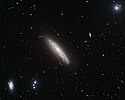NGC 4666
| Galaxie NGC 4666 | |
|---|---|
 | |
| NGC 4666 & NGC 4668 (links unten) – 2,2-m-Teleskop der ESO | |
| AladinLite | |
| Sternbild | Jungfrau |
| Position Äquinoktium: J2000.0, Epoche: J2000.0 | |
| Rektaszension | 12h 45m 08,6s[1] |
| Deklination | −00° 27′ 43″[1] |
| Erscheinungsbild | |
| Morphologischer Typ | SABc: / HII / LINER[1] |
| Helligkeit (visuell) | 10,8 mag[2] |
| Helligkeit (B-Band) | 11,5 mag[2] |
| Winkelausdehnung | 4,5′ × 1,3′[1] |
| Positionswinkel | 42°[2] |
| Flächenhelligkeit | 12,6 mag/arcmin²[2] |
| Physikalische Daten | |
| Zugehörigkeit | Virgo-II-Gruppe LGG 299[1][3] |
| Rotverschiebung | 0.005101 ±0.000017[1] |
| Radialgeschwindigkeit | (1529 ± 5) km/s[1] |
| Hubbledistanz H0 = 73 km/(s • Mpc) | (65 ± 5) · 106 Lj (19,8 ± 1,4) Mpc [1] |
| Geschichte | |
| Entdeckung | William Herschel |
| Entdeckungsdatum | 22. Februar 1784 |
| Katalogbezeichnungen | |
| NGC 4666 • UGC 7926 • PGC 42975 • CGCG 015-015 • MCG +00-33-008 • IRAS 12425-0011 • 2MASX J12450867-0027428 • GC 3198 • H I 15 • h 1420 • HIPASS J1245-00 • LDCE 904 NED243 • HOLM 453A | |
NGC 4666 ist eine Balken-Spiralgalaxie mit aktivem Galaxienkern vom Hubble-Typ SBc im Sternbild Jungfrau auf der Ekliptik. Sie ist schätzungsweise 65 Millionen Lichtjahre von der Milchstraße entfernt und hat einen Durchmesser von etwa 90.000 Lj.
Das System ist eine sogenannte Starburstgalaxie, also eine Galaxie, in der zurzeit besonders viele neue Sterne entstehen. Zu derart hohen Sternentstehungsraten kommt es, wenn sich Galaxien gegenseitig durch ihre Schwerkraft beeinflussen, was in diesem Fall unter anderem durch NGC 4668 geschieht.[4]

Die Supernovae SN 1965H (Typ-IIP) und ASASSN -14lp (Typ-Ia) wurden hier beobachtet.[5]
Das Objekt wurde am 22. Februar 1784 von William Herschel entdeckt.[6] Im selben Himmelsareal befinden u. a. die Galaxien NGC 4642, NGC 4653.
NGC 4666-Gruppe (LGG 299)
Gemeinsam mit NGC 4632 und NGC 4668 bildet NGC 4666 die kleine Galaxiengruppe LGG 299.
| Galaxie | Alternativname | Entfernung/Mio. Lj |
|---|---|---|
| NGC 4666 | PGC 42975 | 65 |
| NGC 4632 | PGC 42689 | 73 |
| NGC 4668 | PGC 42999 | 69 |
Weblinks
- Invisible Galactic Gale
- SIMBAD Astronomical Database
- ESO: Die Superwindgalaxie NGC 4666 +Fotos&Animationen – 1. September 2010
Einzelnachweise
Auf dieser Seite verwendete Medien
Autor/Urheber:
(Credit) ESA/Hubble & NASA, O. Graur
Acknowledgement: L. Shatz, Lizenz: CC BY 4.0Invisible Galactic Gale
NGC 4666 takes centre stage in this image from the NASA/ESA Hubble Space Telescope. This majestic spiral galaxy lies about 80 million light-years away in the constellation Virgo, and is undergoing a particularly intense episode of star formation. Astronomers refer to galaxies which are forming stars anomalously quickly as starburst galaxies. NGC 4666’s starburst is thought to be due to gravitational interactions with its unruly neighbours — including the nearby galaxy NGC 4668 and a dwarf galaxy.
NGC 4666’s burst of star formation is driving an unusual form of extreme galactic weather known as a superwind — a gigantic transfer of gas from the bright central heart of the galaxy out into space. This superwind is the result of driving winds from short-lived massive stars formed during NGC 4666’s starburst as well as spectacularly energetic supernova explosions. Two such supernova explosions have been seen in NGC 4666 within the last decade — one in 2014 and the other in 2019. The star which led to the 2019 supernova was recently determined to be 19 times as massive as our Sun!
At peak, supernovae are often the brightest sources of light in their galaxies, shining so bright that they can be seen clear across the Universe. The 2014 supernova in NGC 4666 is still active in this image, but more than 900 days after it peaked, the supernova has faded from its former glory and looks like just one more star in this busy galaxy.
Though the torrent of superheated gas emanating from NGC 4666 is truly vast in scale — extending for tens of thousands of light-years — it is invisible in this image. The superwind’s extremely high temperature makes it stand out as a luminous plume in x-ray or radio observations, but it doesn’t show up at the visible wavelengths imaged by Hubble’s Wide Field Camera 3. Links
Video of An Invisible Galactic Gale
Credit:
ESA/Hubble & NASA, O. Graur Acknowledgement: L. Shatz
Coordinates Position (RA): 12 45 8.80 Position (Dec): 0° 27' 23.68" Field of view: 2.61 x 1.70 arcminutes Orientation: North is 17.4° left of vertical Colours & filters Band Wavelength Telescope Optical B 438 nm Hubble Space Telescope WFC3 Optical V 555 nm Hubble Space Telescope WFC3 Optical r 625 nm Hubble Space Telescope WFC3 Optical I 814 nm Hubble Space Telescope WFC3.
Autor/Urheber: ESO/J. Dietrich, Lizenz: CC BY 4.0
This visible light image, made with the Wide Field Imager on the MPG/ESO 2.2-metre telescope at the La Silla Observatory in Chile, shows the galaxy NGC 4666 in the centre. It is a starburst galaxy, about 80 million light-years from Earth, in which particularly intense star formation is taking place. The starburst is thought to be caused by gravitational interactions with neighbouring galaxies, including NGC 4668, visible to the lower left. A combination of supernova explosions and strong winds from massive stars in the starburst region drives a vast outflow of gas from the galaxy into space — a so-called “superwind”. NGC 4666 had previously been observed in X-rays by the ESA XMM-Newton space telescope, and these visible light observations were made to target background objects detected in the earlier X-ray images. This picture, which covers a field of 16 by 12 arcminutes, is a combination of twelve CCD frames, 67 megapixels each, taken through blue, green and red filters.

